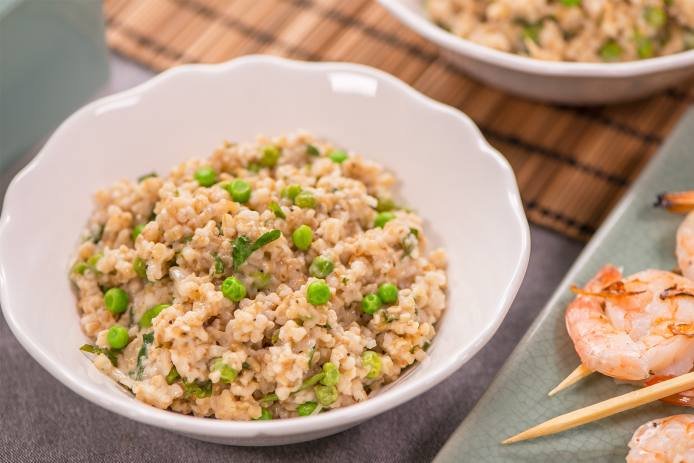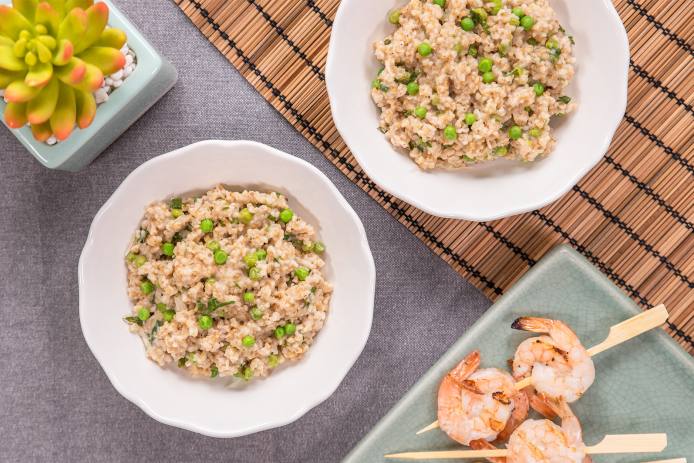You may have seen tv shows or read recipes that portray risotto as a challenging and time-consuming dish. Well, we can get you around the challenging part and as far as time-consuming goes – do you have 30 minutes? If so, let’s do this.
Traditionally, risotto is most often made with Arborio rice – a short-grained, high-starch rice known for its creamy texture, one of the defining characteristics of risotto. To get that creaminess, stock must be added to the rice slowly and the mixture must be stirred almost constantly to help coax the starches out of the rice. And you can’t just cook the heck out of it and hope for the best. Along with that velvety sauce surrounding the rice, you want the rice itself to be slightly al dente.
Hmmm… sounds like a job for steel cut oats.
First of all – al dente? You betcha. Steel cut oats have that same “toothsome” quality that we’re looking for. And creamy? Oh, man. Do they get creamy.
Where traditional rice-based risottos depend on the natural starches from the rice for the creaminess, steel cut oats get positively velvety thanks to all of the beta-glucan fiber contained within the grain. When the oats are simmered in stock, the beta-glucan fiber absorbs the water, creating exactly the texture we want for risotto.
Our oat risotto starts out like any other, shallots and garlic are sautéed in olive oil before the oats are added and allowed to toast a little. Wine is then added and allowed to cook off before the stock is added. We keep our stock simmering and add one ladleful at a time, allowing the oats to absorb most of the liquid before adding the next.
A few stirs in-between is enough to keep things on track. Keep an eye on it, but don’t feel that you have to babysit it or stir until your arm feels ready to fall off. Just keep adding stock when it needs it and let the beta-glucan do its thing.
Once your oats are al dente and creamy and have taken in all of the stock, you can finish your risotto with the peas and parmesan and make any final adjustments to the seasoning.
And don’t forget to take a moment to pat yourself on the back for pulling off such a challenging dish.

Risotto d’avoine au parmesan et aux pois
Ingrédients
- 1 c. à s. d'huile d'olive (15 ml)
- 1 échalote émincée
- 2 gousses d'ail émincée
- 1 tasse d'avoine coupée à la lame d’acier (250 ml)
- 1 c. à s. de beurre (15 ml)
- 1/2 tasse de vin blanc sec (125 ml)
- 5 tasses de bouillon de poulet faible en sel ou de bouillon de légumes (1250 ml)
- 1/2 tasse de petits pois surgelés, décongelés (125 ml)
- 1/2 tasse de parmesan (125 ml)
- 2 c. à s. de persil finement haché (30 ml)
- pincée de poivre noir
Instructions
- Porter le bouillon à ébullition et maintenir à feu moyen-doux pendant que vous préparez les autres ingrédients.
- Dans une grande casserole à feu moyen-vif, faire sauter l'échalote jusqu'à ce qu'elle soit ramollie, mais non dorée.
- Ajouter l'ail, le beurre et l'avoine coupée à la lame d’acier et cuire 1 minute en remuant constamment.
- Ajouter le vin et cuire jusqu'à absorption complète.
- Ajouter le bouillon, une louche à la fois, en remuant fréquemment, cuire jusqu'à ce que le liquide soit presque absorbé avant d'en ajouter davantage. L'avoine doit être cuite en environ 25 minutes - elle sera al dente et crémeuse.
- Retirer du feu et incorporer le poivre, le persil, le fromage et les pois.
- Remarque: si vous n’avez pas de bouillon à faible teneur en sel, vous pouvez diluer le bouillon ordinaire 1: 1 avec de l’eau.




